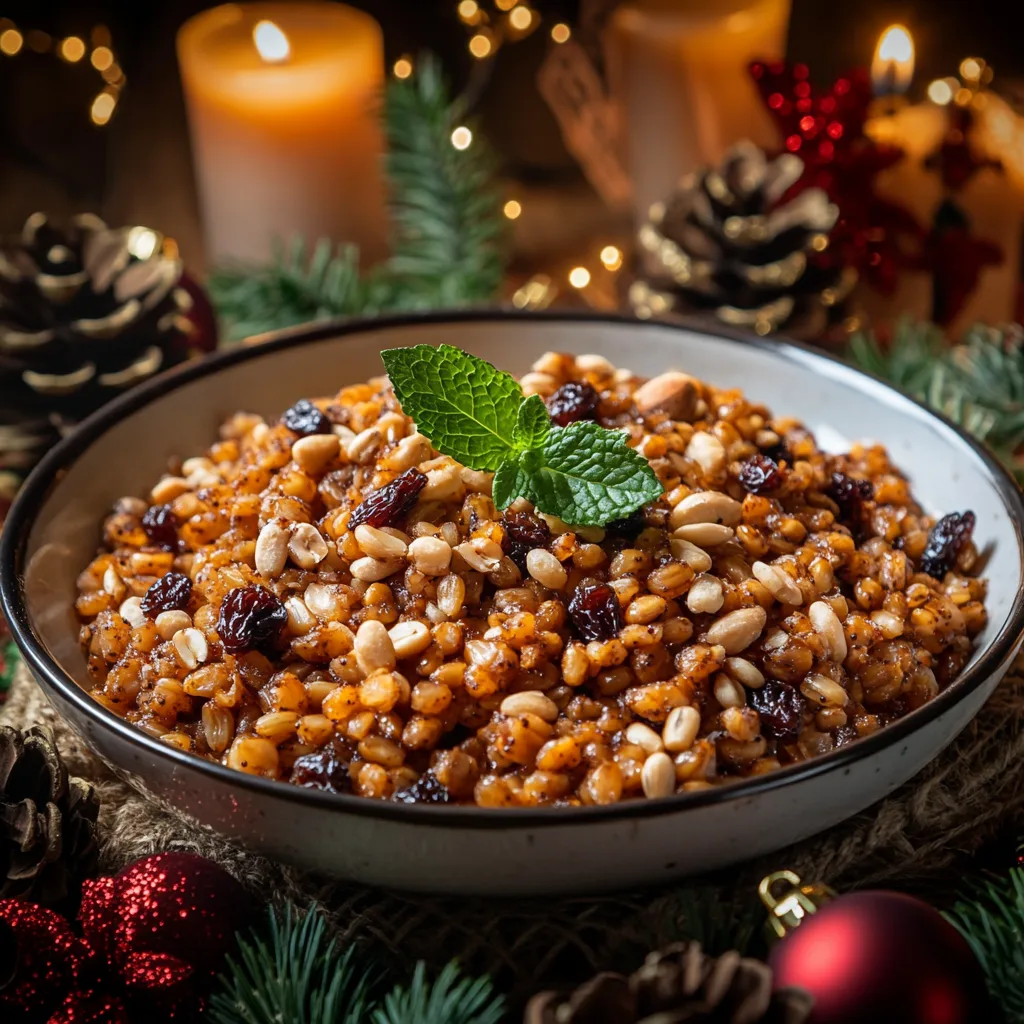Part 1: Origins, Tradition, Ingredients & Preparation
Introduction: What Is Kutia and Why Is It So Special?
Kutia is a traditional ceremonial dish prepared in many Eastern European households, especially for Orthodox Christmas Eve. Deeply rooted in Ukrainian, Polish, Belarusian, and Russian cultures, it is considered a sacred offering — symbolic of family unity, ancestors, and the cycle of life and death.
This rich, porridge-like dessert combines wheat berries, honey, poppy seeds, raisins, and nuts, and is often the first of the 12 dishes served during the Sviata Vecheria. If you’re exploring a deeper connection to Slavic food traditions, this guide will walk you through the full history, ingredients, preparation steps, and symbolic value of this cherished recipe.
For more context on Christmas Eve tables, check out this guide to the 12 traditional dishes, where Kutia plays a starring role in most Ukrainian homes.
Also, if you’re interested in Eastern European meals beyond the holidays, you might enjoy our recipe for traditional Eastern European dishes like beetroot-based borscht.
🌾 Historical Origins and Sacred Meaning of Kutia
The origins of Kutia trace back to pagan rituals, where wheat symbolized rebirth and the continuity of life. As Christianity spread through Eastern Europe, the dish was adopted into Orthodox Christian traditions, becoming a core part of Christmas Eve meals.
Why is Kutia sacred?
- It honors ancestors and the deceased.
- It’s the first dish served on the table — representing eternal life.
- The main ingredients (wheat, honey, poppy seeds) carry deep symbolic meanings.
In Ukrainian culture, it is customary for the head of the household to take the first spoonful and offer it to the spirits of ancestors. Some even toss a spoonful toward the ceiling — the more grains that stick, the better the harvest or luck in the coming year.
This spiritual meaning connects directly with food as culture and ritual. As seen in how to make pierogi, many Slavic dishes have similar ceremonial undertones.
🌍 Regional Kutia Variations Across Eastern Europe
While Kutia is most commonly associated with Ukrainian Christmas, similar versions exist across the Slavic world:
Ukrainian Kutia
- Made with wheat berries, honey, poppy seeds, raisins, walnuts
- Sometimes includes cream or milk for a richer version
Polish “Kutia” (or “Kucja”)
- Often adds orange peel, almonds, and dried fruits
- Slightly sweeter and more dessert-like
Belarusian and Russian Variants
- Called “Kolivo” in Orthodox Christianity for memorial services
- Can include barley or rice instead of wheat
- May contain sweet fruit preserves
Modern cooks adapt Kutia using gluten-free grains like quinoa, or replace honey with maple syrup for a vegan touch.
🛒 Traditional Ingredients Used in Kutia
The magic of Kutia lies in its simplicity. Each ingredient has a symbolic meaning, often tied to life, fertility, and peace.
Essential Ingredients:
- Wheat berries – represent immortality and rebirth
- Poppy seeds – symbolize peace, rest, and fertility
- Honey – denotes sweetness of life and divine blessing
- Nuts (walnuts or almonds) – fertility, strength
- Raisins – add natural sweetness and represent the fruits of the earth
Optional Add-ins:
- Dried figs, chopped dates, prunes
- Citrus peel or orange zest (common in Polish versions)
- Heavy cream or milk (for a more decadent version)
Tip: Use organic, whole ingredients when possible. Kutia is more than food — it’s a sacred connection to tradition and family.
🧂 Preparing Kutia: Step-by-Step Ingredient Prep
Before combining your ingredients, each component must be thoughtfully prepared. This process is almost meditative — a way of connecting with generations of cooks before you.
1. Cook the Wheat Berries
- Rinse well under cold water.
- Soak overnight if desired (optional, speeds up cooking).
- Simmer in water (1 cup wheat to 3 cups water) for 1.5–2 hours until soft but chewy.
- Drain and cool completely.
2. Soak the Poppy Seeds
- Cover with boiling water and soak for 30 minutes.
- Drain and grind using a poppy seed grinder or food processor until milky white in color.
3. Prepare the Honey
- Warm gently to liquefy.
- Do not boil — this preserves natural enzymes.
4. Toast and Chop the Nuts
- Toast walnuts or almonds in a dry pan for 3–5 minutes.
- Let cool before chopping.
5. Hydrate the Raisins
- Soak in hot water for 10–15 minutes.
- Drain thoroughly to avoid sogginess.
Want to learn how to reuse traditional ingredients thoughtfully? Take a look at our tips for reusing wholesome ingredients in traditional recipes.
🎄 The Role of Kutia in Christmas Eve Celebrations
Kutia isn’t just a dish — it is the gateway to the sacred meal on Christmas Eve in Eastern Orthodox households.
- It is the first of the 12 dishes served during Sviata Vecheria (Holy Supper).
- A candle is lit, and prayers or hymns are said before the first bite.
- The first spoonful is often left out overnight as an offering to departed ancestors.
Fun Cultural Tidbit: In rural Ukraine, families sometimes throw a spoonful of Kutia onto the ceiling — the more grains that stick, the better the family’s luck and harvest in the new year!
This dish plays a similar symbolic role in memory and tradition as other staples like beetroot soup and Christmas desserts.
Part 2: Recipe, Variations, FAQs & Final Thoughts
🍯 How to Make Traditional Ukrainian Kutia (Step-by-Step Recipe)
Kutia is a humble yet sacred dish, and making it properly is part of its cultural legacy. Below is a classic recipe — authentic and time-honored — that you can prepare to honor tradition or simply enjoy a deeply meaningful dish.
Ingredients:
- 1 cup whole wheat berries
- 3–4 cups water
- 1/2 cup poppy seeds
- 1/3 cup honey (or to taste)
- 1/3 cup chopped walnuts
- 1/4 cup raisins (golden or regular)
- Optional: dried figs, prunes, orange zest, cream
Instructions:
- Prepare the wheat berries: Rinse, soak overnight (optional), then simmer for 1.5–2 hours. Drain and cool.
- Soak the poppy seeds: Soak in hot water for 30 minutes, drain, and grind until milky.
- Toast and chop the walnuts: Toast dry for 3–5 minutes, cool, and chop.
- Soften raisins: Soak in hot water for 15 minutes, then drain.
- Mix: Combine wheat, poppy seeds, honey, raisins, and walnuts. Stir well and adjust sweetness to taste.
- Chill: Refrigerate for 2–4 hours (or overnight). Serve cold or at room temperature.
Tip: For a richer version, add a few tablespoons of sweetened cream just before serving.
If you’re looking for a classic pairing, serve Kutia alongside pierogi or other Slavic comfort food staples.
🌿 Kutia Recipe Variations for Modern Diets
Kutia is incredibly flexible and easy to adapt to different dietary needs:
🌱 Vegan Kutia:
- Replace honey with maple syrup or agave
- Use plant-based cream if needed
- Add dates or figs for extra richness
🥛 Creamy Kutia:
- Add 1/4 cup cream or condensed milk
- Sprinkle cinnamon or nutmeg for warmth
🍚 Gluten-Free Kutia:
- Substitute wheat berries with:
- Cooked quinoa
- Brown rice
- Hulled buckwheat
🍬 Low-Sugar Kutia:
- Reduce or omit honey
- Use chopped apples or prunes for natural sweetness
- Add orange zest or cinnamon for flavor
These updates show how ancient recipes evolve with modern lifestyles. For more ideas on smart ingredient swaps, read our article on what is considered a healthy dish.
🧊 Serving & Storage Tips
How to Serve Kutia:
- Cold or room temperature is traditional
- Serve in earthenware or wooden bowls for authenticity
- Garnish with extra nuts or zest for presentation
Make-Ahead & Storage:
- Prepare 1–2 days in advance — flavor deepens over time
- Store covered in the fridge for up to 4 days
- Can be frozen for 2 months in airtight containers
Looking for meal-planning help? Explore our guide on using leftovers in traditional recipes.
🩺 Health Benefits of Kutia’s Natural Ingredients
Kutia isn’t just meaningful — it’s nutritious too:
🌾 Wheat Berries:
- Rich in fiber and plant-based protein
- Complex carbs = longer satiety
🌰 Walnuts:
- Omega-3 fatty acids
- Heart and brain health
🐝 Honey:
- Natural antioxidant
- Soothes the digestive tract
🌱 Poppy Seeds:
- High in calcium, iron, and phosphorus
🍇 Raisins:
- High in potassium and antioxidants
For an in-depth guide, visit Healthline’s article on the benefits of whole grains.
🙋 Frequently Asked Questions
What is Kutia made of?
Traditional ingredients include wheat berries, honey, poppy seeds, raisins, and nuts. Some versions add dried fruits, cream, or citrus.
Is Kutia the same as Kolivo?
No. Kutia is festive and served at Christmas. Kolivo is a memorial dish made for honoring the dead in Orthodox traditions.
Can I make Kutia gluten-free?
Yes — replace wheat with quinoa, rice, or buckwheat.
How far in advance can I make Kutia?
1–2 days is ideal. It gets better after chilling and resting.
Can I serve it warm?
Traditionally, it’s served cold or at room temperature. A warm version is fine for creamy adaptations.
Does Kutia freeze well?
Yes. Store in the freezer up to 2 months. Thaw in the fridge before serving.
🧾 Final Thoughts: Why Kutia Is More Than a Recipe
Kutia is more than a sweet, nourishing dish — it’s a spiritual and cultural tradition handed down over generations. Preparing it with care connects you to your ancestors, to the land, and to the rhythm of winter celebrations.
Whether you’re cooking for a holiday or seeking a deeper connection to cultural food traditions, Kutia offers a beautiful way to nourish body, heart, and soul.
Want more recipes that blend health and heritage? Visit CharlieRecipes.com for family favorites rooted in timeless traditions.


1 thought on “How to Make Kutia – Traditional Ukrainian Christmas Dish”
Comments are closed.